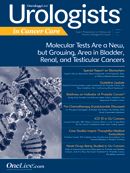Publication
Article
Oncology Live Urologists in Cancer Care®
Robotic Prostatectomy Rises, and So Do Costs: Study Tracks Patterns
Author(s):
Robotic-assisted radical prostatectomy (RARP) was widely adopted in the United States between 2003 and 2010, mainly among high-volume surgeons.
Steven L. Chang, MD, MS
Robotic-assisted radical prostatectomy (RARP) was widely adopted in the United States between 2003 and 2010, mainly among high-volume surgeons.
The trend, which began after RARP was introduced into practice in 2001 and has since leveled off, has resulted in centralization of care and driven up costs for radical prostatectomy across the board, concluded the authors of a large retrospective study, who are based at Harvard and Stanford universities. The study was published in June, online, in the journal BJU International.
“Given its high costs, RARP adoption seems contradictory to contemporary efforts for cost containment,” wrote Steven L. Chang, MD, MS, instructor of Surgery at Harvard Medical School and associate surgeon at Brigham and Women's Hospital, and colleagues. “We suspect that RARP diffusion has remained robust due to an absence of pressures to curtail adoption.”
Specifically, insured patients aren’t motivated to avoid RARP because they don’t pay more for the procedure than for open or laparoscopic radical prostatectomy; nor do surgeons, the authors theorized. They added that surgeons may be motivated to conduct RARP because it is associated with a rise in patient volume.
“The hospital, which typically carries the financial responsibility for robotic surgery, may also have encouraged RARP adoption: after allotting up to $2.5 million to purchase each robotic unit, there is probably pressure to use the robotic equipment, even at a loss, to increase or avoid losing market share for [radical prostatectomy],” the authors added.
The study looked at 65,775 men who had undergone radical prostatectomy in the United States during the target years; one-third of the men underwent RARP, while the others received either open prostatectomy or laparoscopic prostatectomy. The authors found information about the men and details about their treatment in the Premier Hospital Database, which they described as nationally representative and capturing 20% of inpatient hospital discharges in the United States.
For each study year, the investigators determined which of the patients’ doctors conducted 50% or more of their annual radical prostatectomies using RARP, and identified the changes in practice patterns and expenditures that arose as more doctors entered that category.
The study was needed because other investigators had primarily conducted single-institution studies focused on high-volume surgeons, without evaluating patterns in the larger medical community, the authors wrote.
Chang et al found that, in 2003, 0.7% of surgeons who regularly performed radical prostatectomies had adopted RARP; by 2010, that percentage had increased to 42%.
Defining high-volume surgeons as those who performed more than 24 radical prostatectomies per year, the authors found that those physicians had statistically significantly higher odds of adopting RARP throughout the study period.
From 2005 to 2007, the authors noted, adoption of RARP was more common among surgeons at teaching hospitals (odds ratio [OR] 2.4, 95% confidence interval [CI] 1.7-3.4), intermediate-sized hospitals (200-399 beds; OR 5.96, 95% CI 1.3-26.5), and large hospitals (≥400 beds; OR 6.1, 95% CI 1.4-25.8). After 2007, adoption was more common among surgeons at urban hospitals (OR 3.3, 95% CI 1.7-6.4).
RARP adoption was associated with increased volume of radical prostatectomies, and so occurred most frequently among high-volume surgeons and least frequently among low-volume surgeons, defined by the authors as those performing fewer than 5 radical prostatectomies annually.
Overall, the annual number of surgeons performing radical prostatectomy decreased from about 10,000 to 8200, reflecting a decline in the number of low-volume surgeons that was probably associated, in part, with the rise in popularity of RARP, the authors wrote. The proportion of cases performed by high-volume surgeons increased from 10% to 45%, the authors reported.
RARP was more costly, disproportionally contributing to an increase in annual aggregate cost for prostate cancer surgery from $500 million in 2003 to $700 million in 2009, the authors found. However, they wrote, RARP costs generally decreased from a 2003 high of $16,388 to an average of slightly over $10,000. Meanwhile, non-RARP costs increased from just below $8000 to nearly $9000 by the end of the study—a trend that may also have been driven by the popularity of RARP, the authors postulated.
While the price of non-RARP prostatectomies may have risen simply because the procedure takes longer without a robot, they wrote, “An intriguing alternative hypothesis is that surgeons performing non-RARP altered their surgical technique in response to the rising popularity of RARP, thereby elevating surgical complexity, operative time, and cost.”
Chang SL, Kibel AS, Brooks JD, Chung BI. The impact of robotic surgery on the surgical management of prostate cancer in the USA. BJUI. Published online June 23, 2014.










